Excerpts from Jim Conrad's
Naturalist Newsletter
Entry dated March 7, 2024, from notes taken about 2kms south of Higuerillas, Municipality of Cadereyta de Montes; N20.8872°, W99.7718°, elevation ~1660 meters (~5450 feet); bedrock of volcanic rhyolite; local narrow belt of vegetation constituting an extreme southern extension of the Chihuahuan Desert, Meridional Subregion; central Querétaro state, MÉXICO
VELVET BUR CACTUS

While contorting my body to photograph a flower, a sharp pain ignited in a leg. Several small, spiny cactus joints stuck to my trouser leg above where the leg was hurting. This brought a flashback to what's shown a little down our Tasajillo Cactus page, that picture taken in 2007, also here in Querétaro state. Lots of cactus joints have stuck to me since that picture was taken, and always I remember that picture. The leg-stabber turned out to be the well camouflaged being shown atop this page. Some of the offending joints are shown in my hand. Here's a closer look at the main cactus body:

The cactus's cylindrical, jointed stems dangled over a low ledge, sprouting here and there spherical or egg-shaped joints. The cylindrical joints suggested the genus Cylindropuntia, whose spines develop papery epidermal sheaths, which come off if you tug on them. Such sheaths can be seen close-up on our Cylindropuntia tunicata page. When I tugged on one of this cactus's spines, no sheath came off. However, my modest tug did shake loose several spiny joints, which also is typical of certain Cylindropuntia species. The lack of spine sheaths combined with the eager-to-fall side-joints flummoxed me.
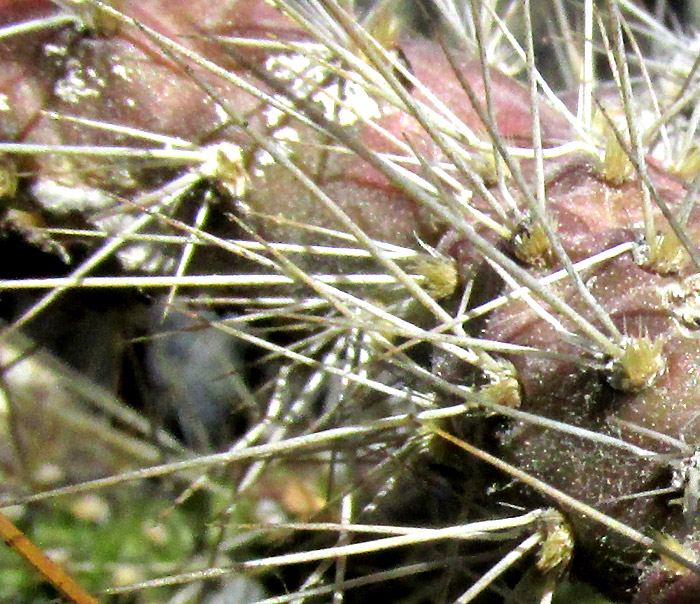
Each spine cluster on larger joints bore up to five or so regular spines, at the base of which grew dense tufts of tiny, slender glochids, glochids being those minuscule items that stick into your fingers even if you avoid being stuck by spines.
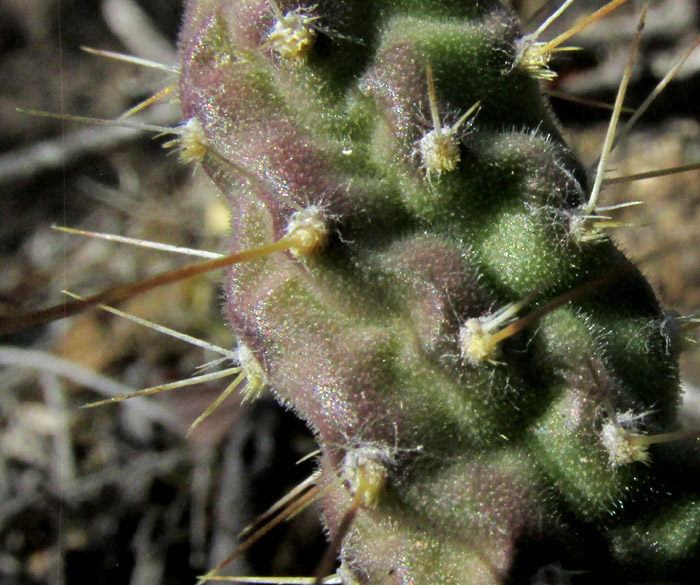
Up close, the joints' surfaces were more velvety-hairy than I've seen on any cactus. The hairs were not only dense, but relatively long.
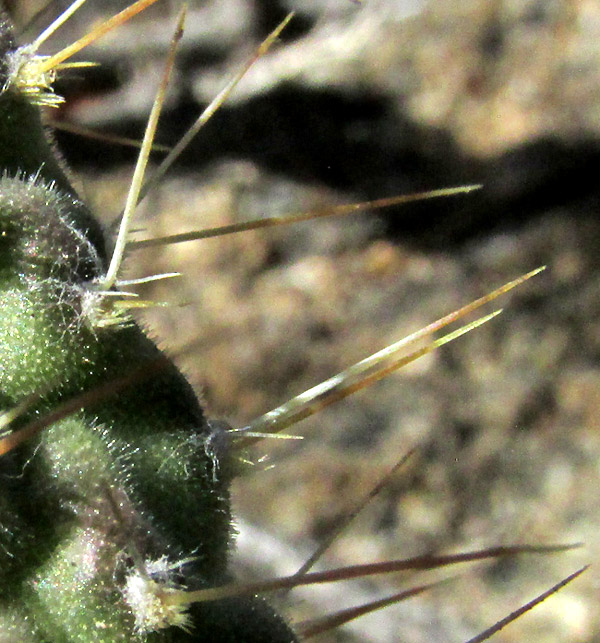
I had trouble identifying this species. To me, if joints were cylindrical on a cactus in central Mexico, it was a Cylindropuntia. In literature I had available, our cactus didn't seem to match any species occurring in our area. In the end, I sought help with the identification.
Someone at Opuntiads.Com was kind enough to write that our leg-stabber brought to mind three pricklypear species constituting a complex of very similar to identical species needing more study: Opuntia pestifer, O.pumila and O. pubescens. When I looked up those names on Kew's Plants of the World Online database, both Opuntia pestifer and Opuntia pumila were considered to be synonyms of OPUNTIA PUBESCENS. Opuntiads.Com pointed out that some experts lump the names while others don't; "More studies are needed." When pictures on the Internet labeled with the names were seen, they matched our plant's appearance.
Opuntia pubescens, as interpreted by Kew, occurs in hot, usually disturbed, scrub-type vegetation in Spanish speaking countries from upland northern Mexico to Honduras, and then again in South America from Venezuela through the Andes to Paraguay. In English it's known as the Velvet Bur Cactus,the name useful in English because the species has become a talked-about, undesired invasive plant well beyond its homeland.
The Opuntia pubescens page of the Hawaiian website of the Coordinating Group on Alien Pest Species (CGAPS) rates our cactus as posing a high risk for invasion. A 2014 paper by Dan'sile Cindi, entitled "The feasibility of eradicating Opuntia pubescens (velvet bur cactus) in the Pretoria National Botanical Garden," says that "All detached cladodes [the joints] and fruit can root and grow to form new plants." We've seen how easily the joints come off, so this is an important point.
Despite its potential orneriness, and bad press, the 2018 study by Álvaro Munguía-Vázquez and others entitled "Uso y conocimiento de cactáceas en la comunidad otomí de El Alberto, en Ixmiquilpan (Hidalgo, México)," reports that among the Otomí indigenous people in the neighboring state of Hidalgo, Opuntia pubescens is used both as a food and an ornamental. The mature fruit is utilized; no information is given as to how.
The 1997 Cactus Family treatment of the Flora del Valle de Tehuacán-Cuicatlán by Salvador Arias Montes and others may suggest why our cactus's truly cylindrical stems confused me. It says that young Opuntia pubescens are round in cross-section, but become slightly flattened-cylindrical with age -- the young stems "... son redondeados y después adquieren una forma ligeramente aplanada-cilíndrica." Apparently identificationliterature I had access to described mature stems with flattened stems, while I had immature ones. The Flora also describes the cactus as a shrub with ascending branches growing up to 80cm tall (2.6ft), while our plant definitely was a dangler.
As they say say, "More study is needed."
entry dated May 9, 2022, issued from near Tequisquiapan, elevation about 1,900m (6200 ft), ~N20.57°, ~ W99.89°, Querétaro state, MÉXICO
MUDDY CACTUS ON A CLIFF
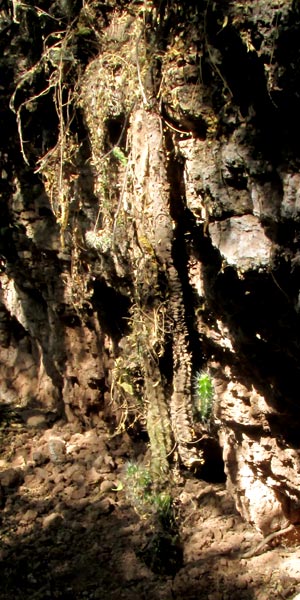 At first you may have problems seeing the cactus at the right because it's so covered with mud, dried-up mesquite leaflets and general forest debris. Look for the green spot emerging from the side a dangling cactus in the image's center. Normally when I find unidentified cacti without flowers I just leave them, but this was in such an unusual habitat and I admired its adaptive resilience so that it seemed to deserve recognition as it is.
At first you may have problems seeing the cactus at the right because it's so covered with mud, dried-up mesquite leaflets and general forest debris. Look for the green spot emerging from the side a dangling cactus in the image's center. Normally when I find unidentified cacti without flowers I just leave them, but this was in such an unusual habitat and I admired its adaptive resilience so that it seemed to deserve recognition as it is.
The habitat is a low rock cliff along a gully, or baranca through an area mostly overgrown with Smooth Mesquite. The rocks are composed of semi-hardened sediment which over the millennia washed down from surrounding hills composed largely of rhyolite, an extrusive igneous rock rich in silica. The cactus roots at the cliff's rim, where muddy water or watery mud washes over it, from behind the cliff. Most of the cactus's body is encased in mud and one wonders how in this shady environment it photosynthesizes enough to keep itself alive. Just the small green sprout is mud free. Below is a close-up of the new stem, with two mud-encased, dangling stems beside it:
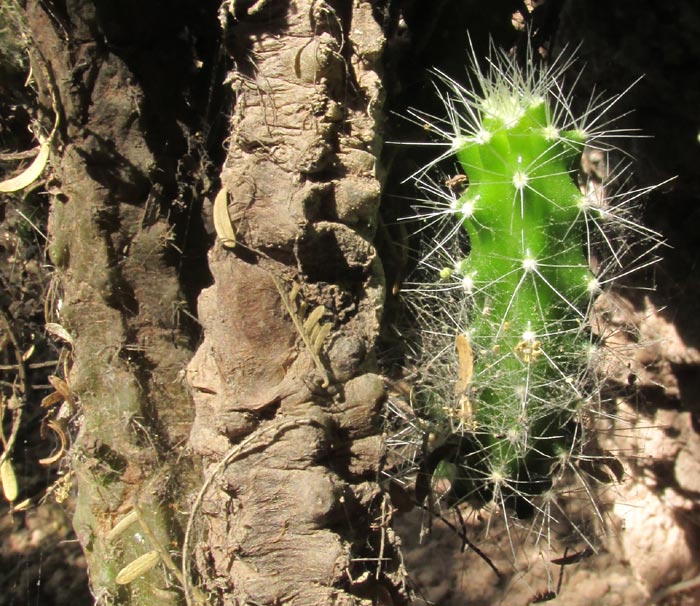
The spine clusters arise atop low bumps, or tubercles, aligned in six rows running vertically, forming a kind of hilly ridge. Below you see that a dozen or so spines radiate from structures called areoles, and that the areoles' surfaces are fuzzy with short, white hairs.
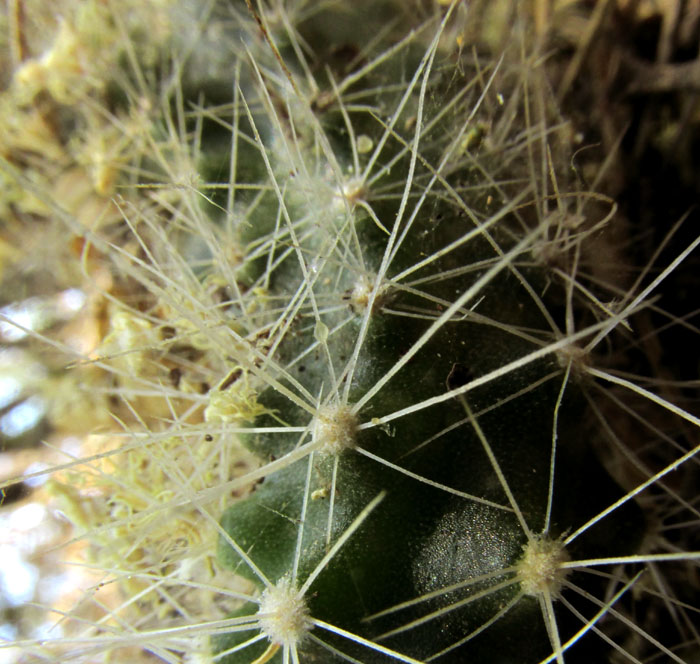
For a good while I've been unable to identify this cactus properly. Later I learned that it's the Velvet Bur Cactus, Opuntia pubescens, profiled in the previous entry.